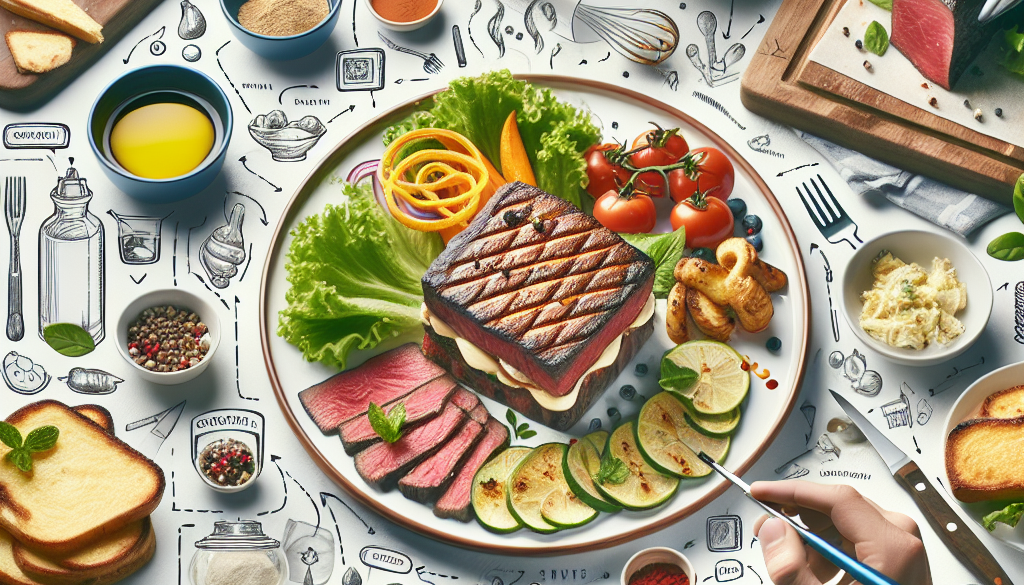Crafting a Mouthwatering Food Prototype: Expert Tips
-
Table of Contents
- Crafting a Mouthwatering Food Prototype: Expert Tips for Success
- Understanding the Importance of Food Prototyping
- Research and Inspiration: The Foundation of Your Prototype
- Ingredient Selection: The Building Blocks of Flavor
- Recipe Development: The Art and Science of Cooking
- Prototyping Process: From Kitchen to Consumer
- Case Studies: Success Stories in Food Prototyping
- Conclusion: Key Takeaways for Crafting Your Food Prototype
- Enhance Your Food Prototype with ETprotein’s High-Quality Protein Products
Crafting a Mouthwatering Food Prototype: Expert Tips for Success

Creating a food prototype is an essential step in the development of new food products. It’s a process that requires creativity, precision, and a deep understanding of culinary science. Whether you’re a seasoned chef, a food scientist, or an entrepreneur looking to break into the food industry, crafting a mouthwatering prototype can be the key to your product’s success. In this article, we’ll explore expert tips and strategies for developing a food prototype that not only tastes great but also appeals to consumers and stands out in the market.
Understanding the Importance of Food Prototyping
Before diving into the tips for crafting a food prototype, it’s important to understand why prototyping is crucial. A food prototype serves as a tangible representation of your concept, allowing you to test and refine your recipe, assess its marketability, and gather feedback from potential customers. It’s the first step in bringing your culinary vision to life and ensuring that it has the potential to thrive in a competitive marketplace.
Research and Inspiration: The Foundation of Your Prototype
Every great food prototype starts with thorough research and inspiration. Begin by studying current food trends, understanding consumer preferences, and identifying gaps in the market. Look for inspiration in different cuisines, innovative cooking techniques, and emerging dietary needs. This foundational step will help you create a product that is not only delicious but also relevant and appealing to your target audience.
Ingredient Selection: The Building Blocks of Flavor
The ingredients you choose for your prototype are the building blocks of flavor and texture. Consider the following when selecting ingredients:
- Quality: High-quality ingredients can make a significant difference in the taste and perception of your product.
- Source: Locally sourced or unique ingredients can add a compelling story to your product.
- Health and Dietary Trends: Catering to health-conscious consumers or specific dietary needs can broaden your product’s appeal.
Remember that the choice of ingredients will also impact the cost, shelf life, and production process of your final product.
Recipe Development: The Art and Science of Cooking
Developing the recipe for your food prototype is both an art and a science. It involves experimenting with different combinations of ingredients, cooking methods, and seasoning to achieve the desired flavor profile and texture. Keep detailed records of each trial, including measurements, cooking times, and any adjustments made. This meticulous approach will ensure consistency and help you refine your recipe to perfection.
Prototyping Process: From Kitchen to Consumer
Once you have a solid recipe, it’s time to create your first prototype. This process involves:
- Scaling: Adjusting your recipe for larger batches while maintaining quality and consistency.
- Packaging: Choosing the right packaging that preserves the quality of your product and aligns with your branding.
- Testing: Conducting sensory evaluations, shelf-life tests, and consumer taste tests to gather feedback and make necessary improvements.
Iterate on your prototype based on the feedback and testing results until you have a product that meets your standards and resonates with your target audience.
Case Studies: Success Stories in Food Prototyping
Examining case studies of successful food prototypes can provide valuable insights. For instance, the development of plant-based meat alternatives involved extensive prototyping to mimic the texture and flavor of real meat. Brands like Beyond Meat and Impossible Foods invested heavily in research and development to create prototypes that eventually revolutionized the food industry.
Another example is the rise of gluten-free products. Companies like Udi’s and Glutino spent years perfecting their recipes to create gluten-free bread and pasta prototypes that closely resemble their wheat-based counterparts, catering to the needs of consumers with celiac disease or gluten sensitivity.
Conclusion: Key Takeaways for Crafting Your Food Prototype
In conclusion, crafting a mouthwatering food prototype is a complex but rewarding process. It requires a blend of creativity, scientific understanding, and strategic thinking. By conducting thorough research, selecting quality ingredients, meticulously developing your recipe, and carefully testing your prototype, you can create a product that stands out in the market. Remember to be patient and persistent, as prototyping is an iterative process that may require several attempts before achieving success.
Enhance Your Food Prototype with ETprotein’s High-Quality Protein Products
If your food prototype requires high-quality protein ingredients, consider incorporating ETprotein’s products into your recipe. ETprotein offers a wide range of organic bulk vegan proteins that are non-GMO, allergen-free, and characterized by a neutral taste. Their protein offerings, including rice, pea, and various seed proteins, can provide the nutritional profile and texture needed for a variety of food prototypes, from sports nutrition bars to plant-based meat alternatives.
With ETprotein’s commitment to quality and purity, you can ensure that your food prototype not only tastes great but also meets the highest standards of health and nutrition. Contact ETprotein to sample their products and elevate your food prototype to the next level.
About ETprotein:
ETprotein, a reputable protein and L-(+)-Ergothioneine (EGT) Chinese factory manufacturer and supplier, is renowned for producing, stocking, exporting, and delivering the highest quality organic bulk vegan proteins and L-(+)-Ergothioneine. They include Organic rice protein, clear rice protein, pea protein, clear pea protein, watermelon seed protein, pumpkin seed protein, sunflower seed protein, mung bean protein, peanut protein, and L-(+)-Ergothioneine EGT Pharmaceutical grade, L-(+)-Ergothioneine EGT food grade, L-(+)-Ergothioneine EGT cosmetic grade, L-(+)-Ergothioneine EGT reference grade and L-(+)-Ergothioneine EGT standard. Their offerings, characterized by a neutral taste, non-GMO, allergen-free attributes, with L-(+)-Ergothioneine purity over 98%, 99%, cater to a diverse range of industries. They serve nutraceutical, pharmaceutical, cosmeceutical, veterinary, as well as food and beverage finished product distributors, traders, and manufacturers across Europe, USA, Canada, Australia, Thailand, Japan, Korea, Brazil, and Chile, among others.
ETprotein specialization includes exporting and delivering tailor-made protein powder and finished nutritional supplements. Their extensive product range covers sectors like Food and Beverage, Sports Nutrition, Weight Management, Dietary Supplements, Health and Wellness Products, and Infant Formula, ensuring comprehensive solutions to meet all your protein needs.
As a trusted company by leading global food and beverage brands and Fortune 500 companies, ETprotein reinforces China’s reputation in the global arena. For more information or to sample their products, please contact them and email sales(at)ETprotein.com today.












